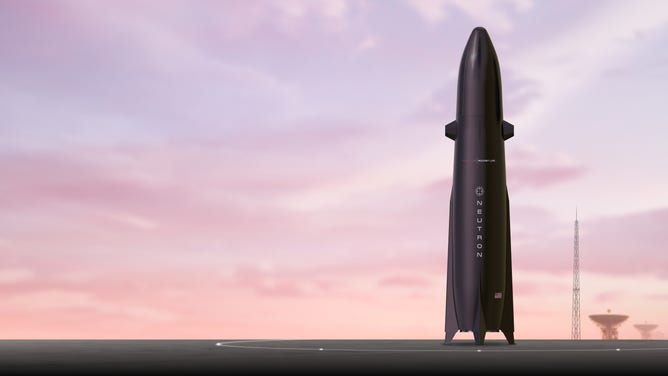Rocket Lab's new reusable rocket Neutron tackles weight of leaving Earth
Neutron is fully reusable from the nose cone down to its landing legs.
One of the most complex parts of space travel is getting off planet Earth. Rocket Lab says that with its new "beast" of a rocket, it will tackle that problem with a specially created lightweight material.
California-based Rocket Lab first began launching its small class rocket, Electron, in 2018 from its launch site in New Zealand. The company quickly branched out, creating an adaptable spacecraft for customers and moving to a reusable rocket recovery method for Electron.
Now, founder and CEO Peter Beck says the company is entering new territory once again with its massive Neutron rocket, designed to launch humans and deep space robotic missions.
The sleek black spaceship stands at 40-meters tall and can launch 15 tons to low-Earth orbit or 8 tons to deep space. It's fully reusable from the nose cone down to the legs it lands on after launch.
If you squint, the rocket's body might look like SpaceX's Starship spaceship currently under development and testing in Texas. However, that's where the similarities stop.
Neutron will launch and land from the same site. A majority of the spaceship will be 3D printed "using an automated fiber placement system which can build meters of carbon rocket shell in minutes," according to Rocket Lab.
It's made of lightweight carbon composite, similar to the material Rocket Lab uses for its smaller Electron rocket. Beck says this material is new and improved to withstand the heat and forces of launch and re-entry.

A rendering of Rocket Lab's Neutron launch vehicle.
(Rocket Lab)
"A huge reduction in weight is a game-changer," Beck said. "If you can take the mass out of the rocket, you take the pain out of propulsion and, quite literally, the heavy lifting."
According to Rocket Lab, Neutron will weigh 480 tons when fully fueled. For comparison, SpaceX's Starship, made of stainless steel, weighs 1,400 tons with fuel.
The fairings, or nose cone, open like a Venus flytrap that closes after the payload deploys in orbit.
"Since reusability is at the heart of the neutron design, we asked ourselves, how could we reuse as much as possible to really drive down those costs and time to get it onto the pad and launch again and again? The answer is not throwing away the fairings or even trying to catch them," Beck said. "This was never get rid of them in the first place."
Rocket Lab is calling them "Hungry Hippo" fairings after the children's game.

A rendering of Rocket Lab's Neutron "hungry hippo" fairings.
(Rocket Lab)
The company has designed a new engine called Archimedes, a reusable liquid oxygen/methane gas engine, to get Neutron into orbit. Seven Archimedes engines will propel Neutron into orbit.
"Because we don't have to look to great big, hulking metal rocket into orbit. It means the engines can be far less stressed," Beck said. "We don't need to push the engines to the absolute maximum."
Beck said teams at Rocket Lab are currently developing prototypes for Neutron, and Archimedes "will breathe its first fire next year."
Rocket Lab is currently selecting a site on the U.S. east coast for its rocket production and launch site. The company estimates it will create 250 jobs to support the new launch vehicle.